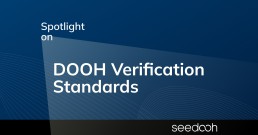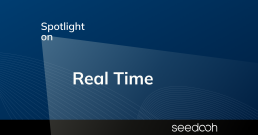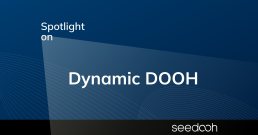Spotlight On… DOOH Verification Standards
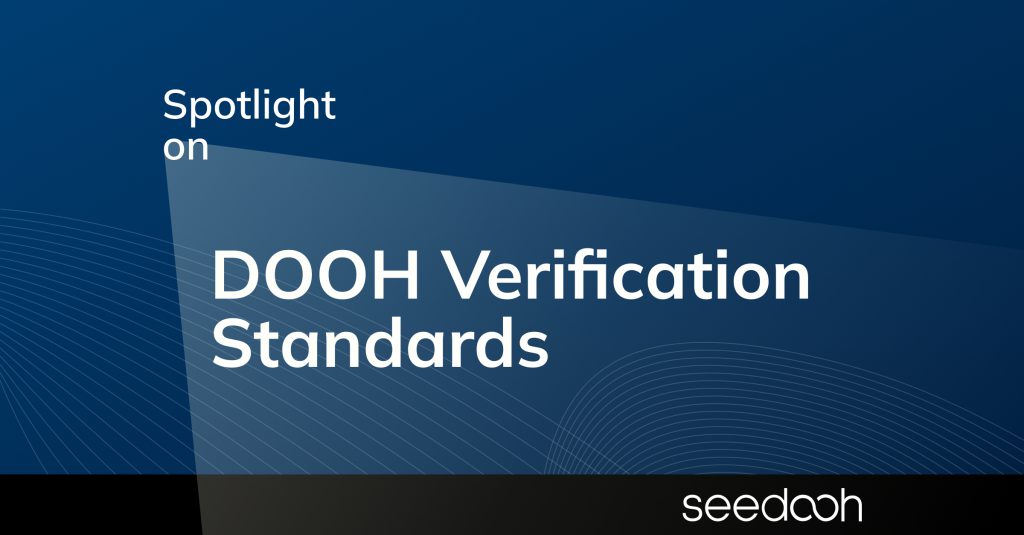
Welcome to a world with Out-of-Home Verification Standards.
Recently, D/OOH Verification Standards have been agreed and published in TWO markets; Australia and New Zealand.
Sector performance figures for Q1 2024 highlight OOH revenue growth of over 9% in both Australia and New Zealand, with DOOH now registering 74% and 78% of total revenue respectively, by market. These are globally leading numbers. And they are testament to the success of long running, significant and co-ordinated investments of effort, time (and money) in assets, data, systems and processes which enable the sector to compete more vigorously with - and more seamlessly complement - other media channels.
Most Brands like using OOH - and it’s never been easier to justify budgets and execute campaigns for this increasingly valuable part of the media plan. As a result, OOH’s share of total media budgets is also growing fast, in this part of the world.
Accountability in delivery has long been viewed (by all parties in ANZ) as a hygiene requirement - just one connected component of this complex evolution. Third Party Verification (TPV) has been available at scale for about 7 years now, firstly via Seedooh’s highly secure API integrations, then later via other TPV’s, preferring a methodology similar to #online verification, using ‘tags’ or ‘pixels’ in DOOH.
But it hasn’t been easy, or quick, to arrive at Verification Standards that are agreed at industry level by both the buy- and sell-side participants. In fact, there has been some quite intense debate over the last few years.
The key points for DOOH, which are common to both Australia and New Zealand, are that:
- In the event of a dispute between TPV data and the log-level data from the system which served the ads to the screen (the ‘player’ component of the CMS) - the source of truth (to settle the dispute) is the system-event data from the player.
- A 4 step dispute resolution process is in place for any occasion where the data-sets do not initially match, to assist in resolution, as above.
These points are illustrative of the recurring challenges that TPV commonly brings in the early stages of an accountability focus on DOOH play-out, where methods born in #online are not always accurate.
Seedooh’s independently verified data is always on and ALWAYS matches the system log data exactly, meaning that all parties using Seedooh to verify and support their campaign delivery don’t need to deal with data disputes. Instead, the in-flight focus is immediately on addressing any delivery issues as they arise.
The frequency and nature of the delivery issues varies widely, depending on the number of formats used and the complexity of the campaign. As a rule of thumb, Seedooh Campaign Analysts are calling out discrepancies between the plan and real world delivery in about 30% of verified campaign weeks in Australia and New Zealand. (This statistic excludes over-delivery, which is prevalent in most campaigns - and enhanced by live campaign monitoring and swift resolution of issues. Seedooh also verifies and quantifies such overdelivery, of course, but we don’t call it out as something that should be swiftly addressed, unless it breaches geographic, time-based or exclusivity parameters).
The outcomes of always on, always accurate TPV are:
- Firstly and most demonstrably - better delivered campaigns due to rapid resolution of identified issues.
- Secondly, less stress on the people managing the campaigns (both sides), as everyone has complete confidence in the real time data. So… even better delivered campaigns, with more time to focus on important things like targeting, measurement, innovation, creativity and insights for improved planning, buying and execution.
- Thirdly, more confidence that OOH campaigns are delivered better, so even more favourable consideration of OOH amongst the complex options for brands seeking optimal media investment solutions.
Well done to the buyers and sellers in New Zealand and Australia for aligning on logical conclusions, so that they can be more focussed on better campaigns for their customers.
And hello to the teams and clients of Omnicom Media Group in New Zealand, who have recently partnered with Seedooh for OOH Verification.
The Australia & New Zealand Standard documents are available here, for further reading:
New Zealand: OOHMAA Verification Standard Feb 2024
Australia: OMA Industry Standards V2.0 Nov 2023
Spotlight On… Real Time
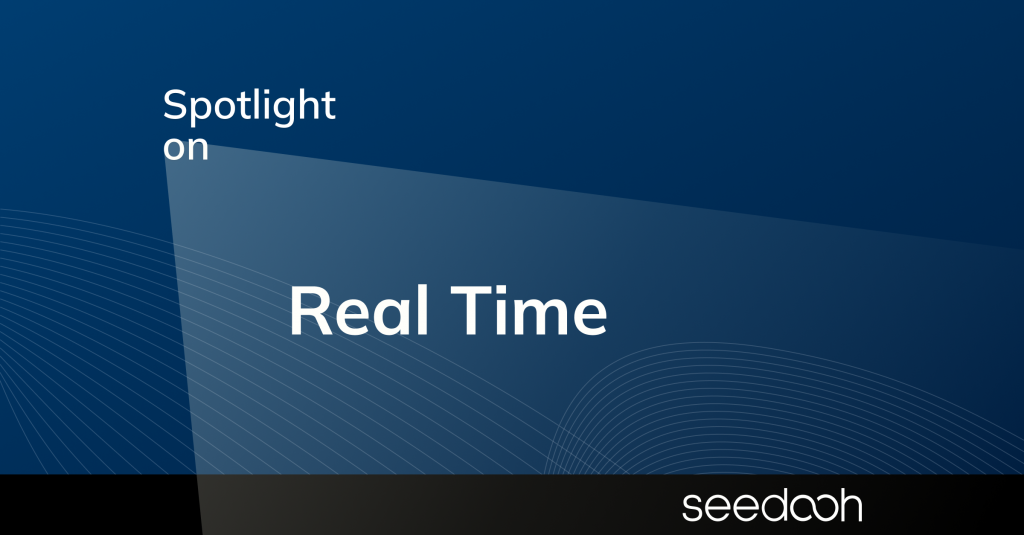
Whether DOOH is bought programmatically, or using ‘RTB’ automated transactions - or booked by email, or phone - it is seldom activated in ‘Real Time’, but can get very close to it, as long as the creative is already approved for public display.
Updates to the message, for example via Dynamic Creative Optimisation (DCO), using pre-approved templates or content, can be very much in Real Time. Even (but rarely, so far) to the point where the message can change, based on who (or what vehicle) is approaching the screen.
This is all testament to the sophisticated technology that runs advanced DOOH networks around the world. And, to the rapid advances made in the last few years, to set up an exciting future for the world's original advertising platform, as it matures into the connected, digital age.
Whilst bookings and creative changes are possible in close to real time, this opportunity is not being taken up much - yet - but scale is surely coming, and soon.
Currently, less than 5% of the (20 million) DOOH plays we verify daily in Australia and New Zealand are either; dynamically enabled, or scheduled / booked in the same hour as they happen. This leaves plenty of scope for growth in Real Time optimisation. The tech is broadly enabled and the connected data, to inform more effective targeting and messaging, is improving rapidly.
Meanwhile, Real Time monitoring of what is actually on-screen is achievable at scale - and it’s an important foundation of Seedooh’s verification and campaign support service, which is included for every campaign we verify for our Agency and Advertiser partners.
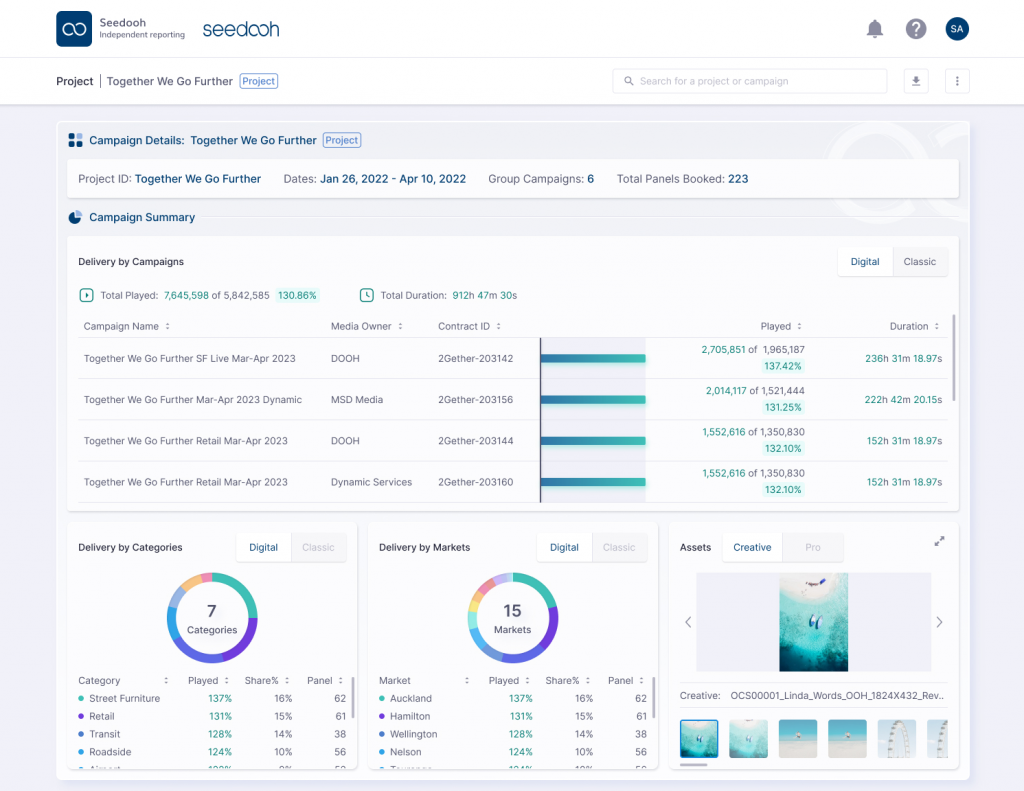
Seedooh Dashboard - example data
Things don’t always go exactly to plan, in the very real world of OOH. Our c.20 million daily play-out system-event data confirms this for us on a regular basis.
That’s why we believe that this Real Time data is so important - if you can get it, and use it effectively.
We have found that Advertisers seeking to achieve the most with their media investment, place high value on our ability to know immediately when something’s not quite right - and get it fixed as soon as possible.
This minimises the impact on their campaigns, in flight. After all, they chose their activity periods carefully, in most cases, to achieve the best possible result.
It’s why we’ve built a technology solution that has always on, server to server integrations. Real Time APIs - and best practice controls - enable 100% accurate, live, third party verification, which can be activated instantly, with no additional steps.
It’s also why our expert analysts, who monitor the live data, go directly to the Operations teams at the Publisher, if there is an issue. We’re using data from the source systems, to alert the people most equipped to address it fast - whilst simultaneously notifying the Advertiser or Agency of the issue, so they know that we are ‘on it’.
Over the last few years, since we launched to market in 2017, Publishers in Australia and New Zealand - and the systems and processes they use - have become noticeably better at delivering campaigns in line with expectations. This makes sense, for these markets, where there is an accountability expectation - and consistently available, independently verified data at scale.
We are now entering the next phase of the DOOH journey. Booking and message parameters are increasingly; more complex, more precise, and more ‘Real Time’ - as they should be, to make the most of the available Adtech and data.
If you’re not getting live data for your campaigns, or the help of expert, independent analysis and support, to help keep the delivery optimised, then you should be.
And there’s no time like the present, to look deeper into the value of Real Time.
Seedooh Spotlight On… South Africa

Insights from the February 2023 nationwide OOH audit, by Outdoor Auditors SA
Guest post, from author: Erik Warburg - Director, Outdoor Auditors, SA
This article was first published in the DOOH.co.za newsletter and blog, on 24th April 2023 - the theme of the issue was “OOH Measurement & Reporting: Counting what matters”
1. Occupancy rates for static OOH continue to improve:
Occupancy rates for static billboards in SA have improved consistently since the nadir or lockdown (Oct 2020). This is particularly encouraging, as this excludes digital OOH, which we know is expanding quickly.

Figure 1: Occupancy rates over time in SA. Source: State of OOH Report
2. Loadshedding is severely impacting delivery on digital OOH
During our Feb 2023 audit, ~25% of roadside digital screens were not working when we audited them. This is very likely due to loadshedding. As an industry, we have to start measuring this under-performance of DOOH accurately so that spend and contracts can be adjusted accordingly. If this doesn’t happen, spend will leave the industry.

Figure 2: The effects of load-shedding on roadside digital
3. Fast food is embracing OOH (and is using it well)
The fast food / QSR category is dominating SA’s OOH market in terms of # of sites used - using almost twice as many sites as the next biggest category (retail banking). This category, led by KFC (SA’s biggest OOH user), has steadily grown it’s reliance on OOH over the past few years.

Figure 3: The biggest OOH categories in SA
Not only do the QSR brands use a lot of OOH, but they are also using it well; formats are well chosen, digital is used well and locations are often carefully considered. Artwork is also well designed for the medium:

Figure 4: Artwork examples from the QSR category
DOOH verification in SA
The need for DOOH verification in SA
Digital Out of Home (DOOH) has grown massively over the past few years. Over the past 4 years the number of roadside digital screens in SA has more than doubled:
Figure 5: the number of roadside digital screens in South Africa over time
This growth in digital is very exciting for the South African OOH industry, as it has the potential to significantly grow the industry. This is particularly attractive as much of this spend would likely come from other media types (e.g. budgets from digital, TV, mobile). Our own forecasts estimate that DOOH is likely to contribute ~40% of all OOH spend within the next 5 years:
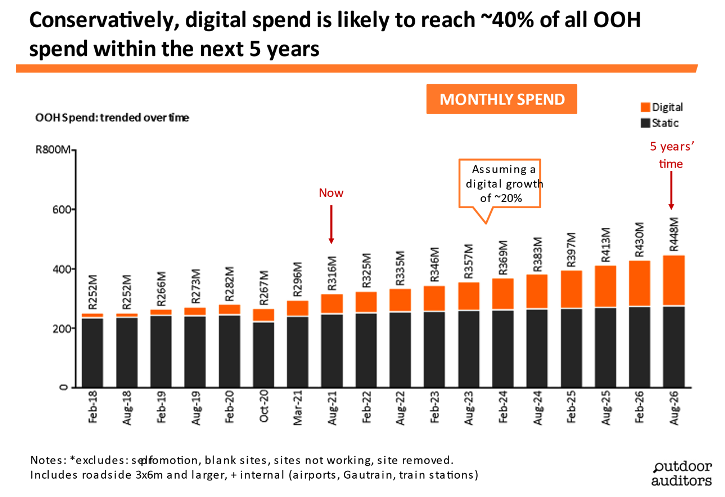
Figure 6: Forecast share of DOOH spend vs static in SA
We are currently riding a wave of demand for digital OOH; the supply of digital assets is increasing, the demand for digital assets is growing quickly, many brands are trying out digital for the first time, and programmatic buying is adding additional demand to the DOOH network.
At Outdoor Auditors, we believe that digitisation offers a powerful opportunity for both media owners and advertisers to make the most of OOH.
We also believe that reporting is an area of critical importance that needs rapid improvement, to help sustain the rapid growth of investment.
We know from our field audits, and from discussions with buyers, that DOOH reporting standards can be very variable. In many cases, it is just not possible for advertisers to be confident that they get what they paid for.
So, what can go wrong?
If advertisers lose confidence in DOOH, this extra spend will quickly migrate to other media types. Already there are advertisers losing confidence in DOOH, because they feel that they are not getting what they are paying for. This is happening for a number of different reasons (these are some of the bigger problems, but not all of them):
- Publishers are over-stuffing loops (playing more ads per loop than agreed upon)
- Load-shedding is resulting in a lot of down-time
- Publishers are over-selling in-demand digital screens, and using quieter screens to make up the flighting numbers
Part of the problem is that it is currently difficult for advertisers to get an independent, holistic view of their entire DOOH holding. In many cases, reports are supplied piecemeal, after the campaign period, and in different formats - or not supplied at all.
This challenge is not unique to South Africa; it is a global shortcoming of OOH. This is now being acknowledged in key markets such as the UK, following a 6 year period of focus in Australia - the first market to address the requirement for standardised, Third Party Verified Proof of Play data at scale..
What is third-party verification?
Third-party verification (TPV or 3PV) is already being used in many industries. It provides the service of confidence, trust and transparency by answering the simple question “Did I get what I paid for”?
The rise in demand for TPV services in OOH is a sign that advertisers have reached a point of expectation of proof of delivery – and prefer that proof to be provided by a third party, rather than self-reported by the OOH supplier.
As TPV becomes more widely available, advertisers will begin to view this service as ‘must’ rather than ‘nice to’ have – a need rather than a preference. While this scale of necessity may not reach a level of sector regulation in South Africa this year, leading Publishers here are already embracing the requirement for transparency, as they have in Australia and the UK.
What are the benefits of third-party verification for DOOH?
On a high-level, TPV brings confidence, trust and transparency to DOOH. As advertisers insist upon third-party verification of their digital spend, publishers ensure that advertisers get what they paid for.
On a more practical level, when TPV is done well, it saves advertisers time, effort, and resources; all monitoring and reporting is done independently, one common reporting tool is used across all publishers and calculating quantifiable non-delivery is made simple. Data is available in real time, meaning that any issues can be quickly identified and rectified timeously, during the campaign period.
Seedooh and Outdoor Auditors SA
Seedooh launched the world’s first scalable Independent Verification Platform for OOH in 2017 in Australia, and is now a global leader in DOOH verification, operating in multiple markets.
Seedooh utilizes backend system integrations, to autonomously and independently query and report on network source data. This is a recognised global best-practice assurance methodology called system event verification. Source data includes both the booking context (what was scheduled, where) and the event data verifying each time an ad is displayed, or a classic panel is installed.
Direct connections to source data events within secure systems (and appropriate controls aligned to a global data assurance standard), ensure Seedooh delivers the most accurate, scalable and secure method for performing verification in OOH. Importantly, this methodology avoids adding extra manual steps into the already complex message delivery process required to operate extensive networks in public spaces.
Seedooh has partnered with Outdoor Auditors to make this service available to the African market.
Outdoor Auditors have been SA’s leading independent source of audited OOH data since 2009 working with clients to provide much-needed competitive and contextual OOH data.
With access to live DOOH data via the Seedooh Platform, Outdoor Auditors can now provide advertisers and agencies with in-flight monitoring of delivery - and campaign support, to identify and help rectify any issues promptly.
Progress to date
Outdoor Auditors and Seedooh can verify delivery of ~50% of DOOH investment in South Africa on demand, so far - and this coverage is growing rapidly as advertiser expectations are made clear.
This includes all roadside DOOH inventory for market leader Primedia Outdoor, who have taken a very progressive position on transparency.
According to Jorja Wilkins, Marketing Executive at Primedia Outdoor:
“Independent, third-party verification is essential for transparency and standardisation in the highly competitive out of home advertising landscape in South Africa. By ensuring that campaigns are accurately reported across all media owners, advertisers can have confidence in the effectiveness of their campaigns, while also promoting fair competition and accountability within the industry."
New levels of accountability are being welcomed by media buyers, too.
Ivor Chalmers, head of OOH for OMG, said: “Third party independent flighting verification is vital if we are to move forward with DOOH and pDOOH especially in these uncertain times where we see an increase in site vandalism, load shedding, cable and panel theft”.
About the author: Erik Warberg, Director, Outdoor Auditors SA
Erik graduated from the University of Cape Town with a B.Sc. in Mathematics, followed by an AdMac course at the Red & Yellow School of Advertising.
After working as a Media Planner and Strategist at DraftFCB and then taking on the role of MD at Posterscope Cape Town, he completed his MBA at the UCT Graduate School of Business, which led to his appointment as a Management Consultant at Bain and Company.
In 2009, Erik founded Outdoors Auditors in partnership with his brother Rene Warburg.
With over 20 years’ experience in the media industry, Erik is passionate about improving the efficiency of the OOH industry, effectively linking supply and demand, and reducing wasted spend.
Seedooh Spotlight On… Issue #1: Dynamic DOOH
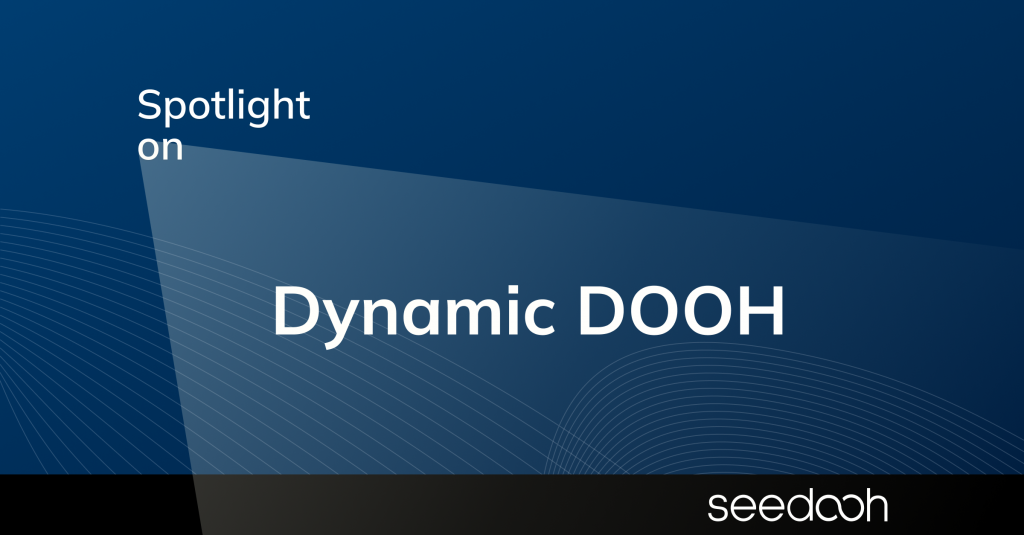
Digital OOH messages can be updated, in real time, automatically. The process is commonly known as Dynamic Delivery, or Dynamic Creative Optimisation (DCO).
NB. This is not the same thing as programmatic DOOH, which is a method of transacting automatically, with improved flexibility and targeting. At this stage, very few, if any, prDOOH campaigns feature Dynamic Delivery – the technical requirements for each ‘thing’ don’t quite fuse together… yet.
Dynamic Delivery (or DCO) has been possible in DOOH for over 10 years. Adoption in Australia and New Zealand has been growing very rapidly in the last 12 months. Here’s why:
1. Contextual Relevance:
- Messages are more effective, the more relevant they are to the audience (if you think about it, this has always been true for any message, in any ‘media’, but the term contextual relevance was first used broadly in the early days of #digital almost 20 years ago – the first truly dynamic opportunity).
- One of the first studies to prove this at scale for OOH was called ‘The Dynamic Difference’, a collaboration between Posterscope and JCDecaux in c.2015. Numerous studies have been published more recently, increasingly sophisticated, and increasingly conclusive. We have linked some easy to read summaries in the footnotes.
- An OOH engagement / effectiveness uplift of 17-38%, just by changing the message, is an opportunity difficult to ignore.
2. Delivery Efficiency:
- The flexibility of DOOH messaging enables Brands to change creative as often as they like (generally) – and many campaigns feature messages that are different by daypart, by day, by location, by format, by environment etc.
- Without an automated Dynamic Delivery solution, the material production, approval, instruction and trafficking of these types of campaigns requires a lot of human resource – and cost – and increases the chance of human error. Especially if the campaign has many formats and suppliers.
3. DOOH Interest:
- Now that DOOH is attracting more of the total media budget, Brands are asking more questions, and are more interested in OOH opportunities. They want to understand the contribution OOH can make to their omnichannel activity – and how to improve this contribution.
- Creative agencies, media agencies, digital agencies and in-housing advertisers are looking for answers – and adapting to the fast evolving maturity of DOOH.
- The focus of these smart people is having a significant impact on the rate of adoption for DCO.
So how does it work?
- Put simply, any number of pre-approved creative versions can be ‘ready to go’ for any DOOH campaign where the media is booked. The message can also include a dynamic element that updates in real time, based on live data.
- If it is just a tagline (eg ‘coming soon’ to ‘now showing’), or a price, or an image / product that is changing, based on known times / dates / locations, then the automated dynamic delivery can be pre-programmed, or ‘scheduled’.
- If you want to link to an external ‘live’ variable, such as time, weather, pollen counts, traffic speed, audience metrics, etc – then this can be connected (where available) and become the trigger that updates the message ‘dynamically’ in relation to the live ‘context’ factors at each sign location.
How do I activate?
- Most leading DOOH publishers have this capability internally now.
- Some media agencies too, and a few creative agencies.
- There are also technology businesses who offer an agnostic solution.
What to watch out for:
- There is an associated cost premium of course, which needs to be weighed against the benefits in both effectiveness and efficiency, in each case. Increasingly, this cost benefit analysis is becoming clearer, technology is improving, and costs are coming down. Some solutions will fare better than others, for specific use cases.
- Like any connected, digital solution, dynamic DOOH message updates require an internet connection, and a stable environment. This is variable in the (very) real world of OOH, where dropouts are fairly common. (Most DOOH systems will continue playing the cached creative, or a fallback creative, until the connection is re-established and new instructions received).
- Some – but not many – solutions are able to report in detail on delivery against expectations. Where this is offered, it is ‘self-reported’ by the system operator(s), and ordinarily provided ‘post-campaign’.
What’s new?
- Seedooh can now verify every play, of every DOOH message – whether traditionally scheduled, or dynamically delivered – and is the only independent, third party verifier who can achieve this.
- Seedooh standardises the data, across multiple publishers, even if they are using different systems – so has a real-time view of every play event in the real world, all in the same platform.
- Seedooh’s Campaign Support service monitors the delivery live, during the campaign and notifies all parties, as soon as an issue is detected – so that there is the best possible chance of rectifying it quickly, and making the most of the booked activity period.
- Seedooh data can also be accessed at scale, during and after the campaign, for analysis and insight, including for attribution / modeling, where other relevant data sets are available.
If you’re interested in learning more about Dynamic Delivery, best-practice third-party verification, or campaign measurement in Public Space Media, contact us here, for an independent opinion, tailored to your (almost certainly) unique requirements.
Footnotes:
2021 | QMS & Neuro Insight | 38% lift in Impact
2022 | Awarion & AdScience | 96% Agree that contextually relevant ads are more eye-catching
